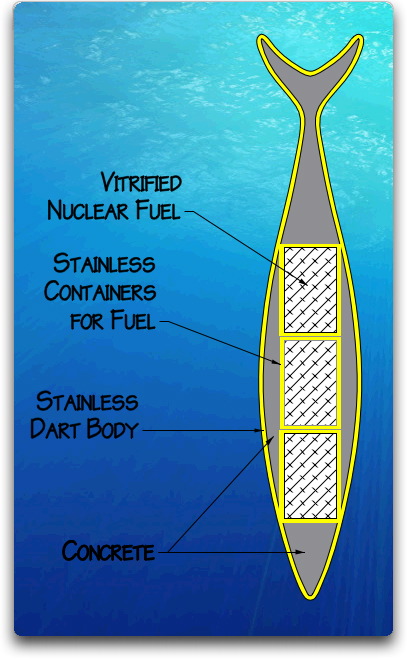Another option for burial of high-level radioactive waste such as spent nuclear fuel rods is burial at sea where it would not be disturbed by geological processes or human activity.
The appeal of ocean floor disposal consists of several different feature. For one thing, in the sediment of the ocean floor, while there is water, it does not flow. If wastes leaked and dissolved, they could take ten thousand of years to migrate through a meter of the dense clay of the ocean floor. Any waste that made it to the open ocean would be very diluted and decayed. In addition, large areas of the ocean floor are geologically stable and unlikely to be disturbed by human activity.
On the other side of the equation is the fact that it would be very difficult to recover the nuclear waste from the ocean floor should it ever become desirable or necessary. And, it would be very difficult to establish an international authority to effectively monitor such activity and enforce adherence to agreed upon rules.
Any waste being disposed of would be encased in shielded canisters and covered with thick shells of concrete. Once the waste has been packaged, it could then be placed in torpedoes which would increase penetration of the ocean floor. An alternative would be to drop the containers in shafts that could be drilled with existing underwater drilling techniques.
Another solution would be to dump containers of waste into subduction zones which are places where one tectonic plate slides under another tectonic plate. The theory is that the containers would be carried deep into the crust of the Earth’s mantle away from the ocean floor and all human activity.
All of these solutions would be vulnerable to natural disasters at sea as well as terrorists during transportation. .
In 1972, the Convention on the Prevention of Marine by Dumping of Wastes and Other Matter was drafted. It is commonly referred to as the London Convention and was put into force in 1975. Currently, over eighty countries are signatory of the London Convention. The Convention is an agreement to control pollution of the sea by dumping and to encourage regional agreements supplementary to the Convention. The Convention only covers deliberate disposal at sea of waste from ships, aircraft and platforms. It does not cover discharges from sources on land from pipes and outfalls, wastes generated from the normal operation of vessels or placement of materials in the ocean for purposes other than disposal. The Convention is currently set to be in force until 2018. If signatory countries want to dispose of nuclear wastes at sea, they will have to pull out of the Convention, lobby for major revision of the Convention or wait for the Convention to expire in 2018.
However attractive disposal at sea might appear for nuclear waste, there are a number of technical and political difficulties that must be overcome before such disposal is a viable option.
Diagram of a design for a nuclear waste disposal torpedo from wattsupwiththat.com:
